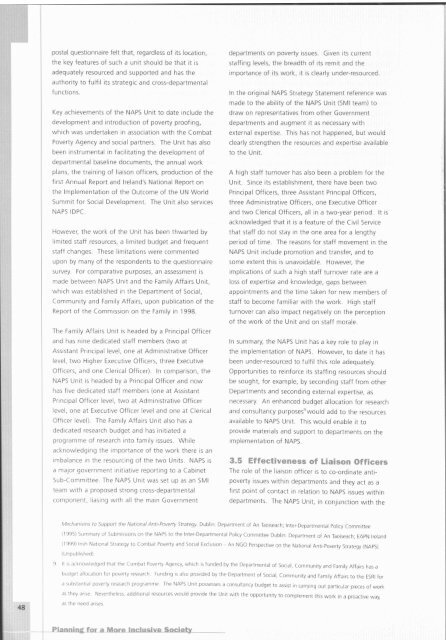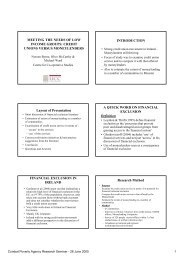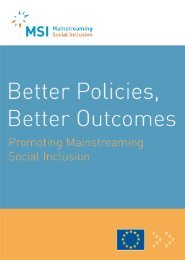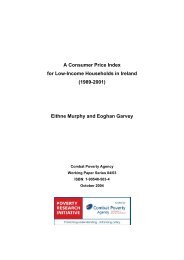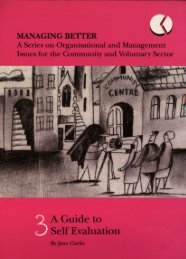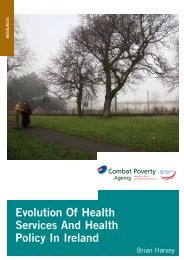Planning for a More Inclusive Society - Combat Poverty Agency
Planning for a More Inclusive Society - Combat Poverty Agency
Planning for a More Inclusive Society - Combat Poverty Agency
You also want an ePaper? Increase the reach of your titles
YUMPU automatically turns print PDFs into web optimized ePapers that Google loves.
postal questionnalre felt that, regardless of its location,the key features of such a unit should be that it isadequately resourced and supported and has theauthority to fulfil its strategic and cross-departmentalfunctions.Key achievements of the NAPS Unit to date include thedevelopment and introduction of poverty proofing,which was undertaken in association with the <strong>Combat</strong><strong>Poverty</strong> <strong>Agency</strong> and social partners. The Unit has alsobeen instrumental in facilitating the development ofdepartmental baseline documents, the annual workplans, the training of liaison officers, production of thefirst Annual Report and Ireland's National Report onthe Implementation of the Outcome of the UN WorldSummit <strong>for</strong> Social Development. The Unit also servicesNAPS IDPC.However, the work of the Unit has been thwarted bylimited staff resources, a limited budget and frequentstaff changes. These limitations were commentedupon by many of the respondents to the questionnairesurvey. For comparative purposes, an assessment ismade between NAPS Unlt and the Family Affairs Unit,which was established in the Department of Social,Community and Family Affairs, upon publication of theReport of the Commission on the Family In 1998.The Family Affairs Unit IS headed by a Principal Officerand has nlne dedicated staff members (two atAssistant Principal level, one at Administrative Officerlevel, two Higher Executive Offlcers, three ExecutiveOfflcers, and one Cler~cal Officer). In comparison, theNAPS Unit is headed by a Princlpal Offlcer and nowhas five dedicated staff members (one at AssistantPrlnclpal Offlcer level, two at Administrative Offlcerlevel, one at Executive Officer level and one at ClericalOfficer level). The Famlly Affalrs Unit also has adedicated research budget and has inittated aprogramme of research Into family issues. Whileacknowledging the importance of the work there is anImbalance in the resourcing of the two Units. NAPS isa major government inlt~atlve reporting to a CabinetSub-committee. The NAPS Unit was set up as an SMIteam wlth a proposed strong cross-departmentalcomponent, llaslng wlth all the maln Governmentdepartments on poverty Issues. Given its currentstaffing levels, the breadth of its remit and theimportance of its work, it is clearly under-resourcedIn the original NAPS Strategy Statement reference wasmade to the ability of the NAPS Unit (SMI team) todraw on representatives from other Governmentdepartments and augment it as necessary withexternal expertise. This has not happened, but wouldclearly strengthen the resources and expertise availableto the Unit.A high staff turnover has also been a problem <strong>for</strong> theUnit. Since its establishment, there have been twoPrinclpal Officers, three Assistant Principal Officers,three Administrative Officers, one Executive Officerand two Clerical Officers, all in a two-year period. It isacknowledged that it is a feature of the Civil Servicethat staff do not stay in the one area <strong>for</strong> a lengthyperiod of time. The reasons <strong>for</strong> staff movement in theNAPS Unit include promotion and transfer, and tosome extent this is unavoidable. However, theimplications of such a high staff turnover rate are aloss of expertise and knowledge, gaps betweenappointments and the time taken <strong>for</strong> new members ofstaff to become familiar with the work. High staffturnover can also impact negatively on the perceptionof the work of the Unit and on staff morale.In summary, the NAPS Unit has a key role to play inthe implementation of NAPS. However, to date it hasbeen under-resourced to fulfil this role adequately.Opportunities to rein<strong>for</strong>ce its staffing resources shouldbe sought, <strong>for</strong> example, by seconding staff from otherDepartments and seconding external expertise, asnecessary. An enhanced budget allocation <strong>for</strong> researchand consultancy purposesgwould add to the resourcesavailable to NAPS Unit. This would enable it toprovide materials and support to departments on theimplementation of NAPS.3.5 Effectiveness of Liaison OfficersThe role of the liaison officer is to co-ordinate anti-poverty issues within departments and they act as afirst point of contact in relation to NAPS issues withindepartments. The NAPS Unit, in conjunction with theMechanlrms to Soppon the Nahonal Anti-<strong>Poverty</strong> Stratwy Dublin Department of An Tao~seach, Inter-Departmental Policy Comm~ttee(1995) Summary of Submlsslons on the NAPS to the Inter-Departmental Policy Committee Dublln Department of An Taolseach, EAPN Ireland(1999) Irish Natlonal Strateqy to Comh.?t <strong>Poverty</strong> and Social Exclusion - An NGO Perspective on the Natlonal ~ntl-poverty Strategy (NAPS)(Unp~~bllshed)9 It 18 arknowledqcd that the <strong>Combat</strong> <strong>Poverty</strong> Aqency whlch 1s funded by the Departmental of Social, Community and Family Affairs has abudqet allocatton <strong>for</strong> poverty research Fund~nq 15 also provided by the Department of Soc~al. Community and Family Affairs to the ESR~ <strong>for</strong>a si~bstantlal poverty research programme The NAPS Unit Possesses a consultancy budget to asslst In carving out particular of workas they arlse Nevertheless add~tlonal resources would provide the Unlt wlth the opportunity to complement this work In a proactive way,as the need arlses<strong>Combat</strong> <strong>Poverty</strong> <strong>Agency</strong>, provided an initial trainlngprogramme <strong>for</strong> liaison officers in mid 1998. Thistraining programme was aimed at increasing liaisonofficers' understanding of NAPS and, within thecontext of the Strategic Management Initiative (SMI),enhancing their abilrty to co-ordinate implementationof NAPS both in and between Departments. Thetraining programme ran over three days with inputsfrom people working in the field of anti-poverty workand SMI.NAPS liaison officers made an input into the postalquestionnaire survey. This was enlightening in itself.Some of them were unclear about thelr role and manyfelt that they were not well enough in<strong>for</strong>med aboutNAPS to complete the questionnaire. There has beena high turnover rate of NAPS liaison officers withindepartments, see Appendlx 4. Many of the currentNAPS liaison officers missed the initial training, andfeedback to the NAPS Unit suggests that many ofthem feel isolated within their departments andunclear of their role. Some departments seem to givethe liaison officers very little support and they take onthis role over and above their other duties.Evidence from other research suggests that liaisonofficers need to have dedicated time and resources tofulfil liaison duties, a clear remit in relation to what isexpected of them and be at a senior enough level tobe able to influence the work of their departments, inthis case in relation to anti-poverty policy (Stutt, C. etal, 1996 and Harvey, B., 1996). The NAPS IDPC,whose remit includes support <strong>for</strong> NAPS liaison officers,needs to take on this issue.3.6 The National Economic andSocial Forum (NESF) and NAPSThe NESF has been given a role In monitoring NAPS.The responses from the postal questionnalre surveyindicated that there was a need to conduct periodicreviews of NAPS. In addition, there was a strongindication from the survey that there was a need toput in place structures to ensure that the communltyand voluntary sector had an input In theimplementation and ongoing monitoring of NAPS.The NESF was <strong>for</strong>mally re-constituted in 1998 and iscurrently considering its role in relation to NAPSGlven its representative structure and focus on policyanalysis and monitoring it would seem to have a keyrole in assessing major social policy init~atlves such asNAPS.3.7 Effectiveness of the <strong>Combat</strong><strong>Poverty</strong> <strong>Agency</strong>The <strong>Combat</strong> <strong>Poverty</strong> <strong>Agency</strong> has been glven a role tooversee an evaluation of the NAPS process, whichwould consider the views and experiences of thecommunlty and voluntary sector. The <strong>Agency</strong> was alsoto provide in<strong>for</strong>mation and education material andsupport government departments and localgovernment in developing anti-poverty strategies.Details on what the <strong>Agency</strong> has done in this regard aredocumented in section 2.7.Some responses to the questionnaire survey indicatedthat there was a lack of ongoing evaluation, and thatthere has been a failure to engage with thecommunity and voluntary sector in the implementationand evaluation of NAPS. It was also suggested bysome of the survey respondents that there was a need<strong>for</strong> "a fully independent authority/body" to review thetargets, ensure that they are systematically evaluatedand to comment on progress made withln NAPS.However, it is acknowledged that the <strong>Agency</strong> hasprovided much background research materlal on theextent and nature of poverty in Ireland, wlth aparticular focus on NAPS. It has endeavoured toinfluence government policy in favour of those livlngin poverty through pollcy submissions. It has poverty-audited the annual budgets since the lntroductlon ofNAPS, and has provided much of the In<strong>for</strong>mationwhich is publlcly available on NAPS. It IS currentlydeveloping a programme of work with local authoritieswlth a view to implementing antl-poverty strategies ata local level.The <strong>Agency</strong> has worked closely wlth the NAPS Unlt toImplement a programme of work to promote andim~lement NAPS.3.8 Effectiveness of Structures <strong>for</strong>llnvollvement of the Communitw andVoluntary SectorThe lnvolvement of the communlty and voluntarysector and people llvlng In poverty was a key elementIn the development of NAPSHowever, slnce thelaunch of the Strategy there has been relatively llttlelnvolvement of the communlty and voluntary sector orpeople llvlng In poverty In the dellvery of the strategyA key flndlng from the quest~onnalre survey,articulated by respondents across all sectors, was thelack of lnvolvement of the cornmunlty and voluntarysector and people llvlng ~n poverty In thelrnplernentatlon of NAPSIt was seen as a verycentrallsed "top-down strateqy The ldck oflnvolvement of the soclal partners was also notedA key challenge In the future lrnplernentat~on of NAPS<strong>Planning</strong> <strong>for</strong> a-<strong>More</strong> <strong>Inclusive</strong>_<strong>Society</strong>I-


